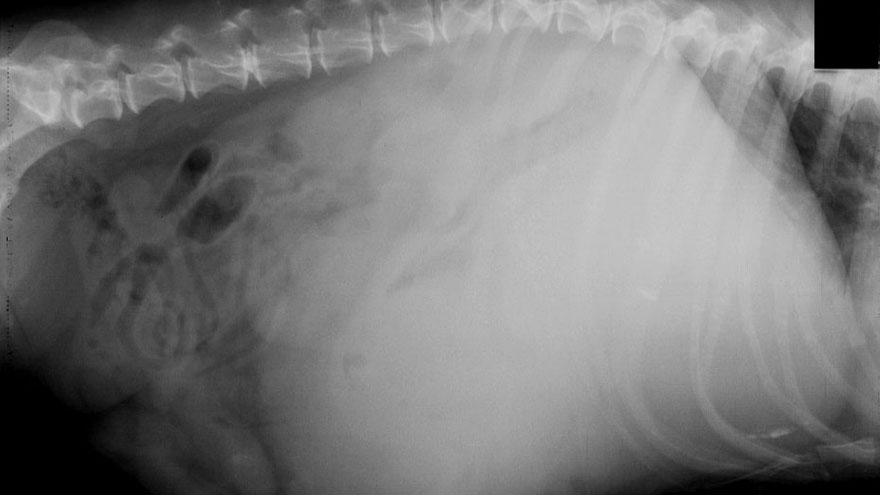Abdominal Tumors in Dogs
Abdominal tumors in dogs aren’t necessarily palpable. That means you or your vet might not be able to feel them unless they are extremely large. Abdominal tumors can affect various internal organs, starting in one and metastasizing to others.
If you feel a lump or swelling on your dog’s abdomen, take him to the vet for an examination. However, most signs of abdominal tumors in dogs involve changes in their eating, drinking and defecation habits.

Stomach Tumors
The majority of canine stomach tumors are malignant. While it’s necessary to remove such tumors, doing so rarely results in a cure. Generally, stomach cancer metastasizes to the liver, lymph nodes or lungs. Breeds predisposed to stomach cancer include the chow, the Belgian shepherd, the rough collie and the Staffordshire bull terrier.
Most dogs affected by stomach cancer show symptoms between the ages of 9 and 10. Signs of stomach cancer include vomiting, appetite and weight loss, drooling, tarry feces and lethargy. After surgery, a dog typically receives chemotherapy. Depending on the type of cancer he has, a dog might live six to eight months after surgery.
Tumors of the Spleen
Your dog’s spleen is situated near his stomach. Its task is to filter blood and create additional red blood cells. Older dogs are more prone to developing splenic tumors, which may or may not be cancerous. Signs of a splenic tumor include abdominal swelling, appetite loss, weight loss, vomiting, fever and small bruises on the skin or in the mouth. The tumor can result in splenic rupture, which can be fatal.
Vets diagnose splenic tumors with ultrasounds, X-rays and biopsy samples. Treatment consists of surgically removing the spleen. However, if a tumor is malignant, it will spread throughout the body. The surgery, followed by chemotherapy, slows down the cancer’s progress. An affected dog might live a year or so after the operation.
Cancer of the Blood Vessels
Hemangiosarcoma is cancer of the blood vessels that originates in the spleen or liver, then spread to the lungs, heart or brain. A blood-fed tumor can burst, causing a dog’s death. Males dogs are at greater risk than females; older canines are at greater risk than younger ones. Great Danes, boxers, golden retrievers, German shepherds and English setters appear to be predisposed.
Symptoms include rapid heart beat, loss of coordination, weight loss, lethargy, seizures and pale mucous membranes. This is one tumor that may be palpable. Sometimes, no symptoms are seen other than death; a necropsy will confirm whether hemangiosarcoma was at hand. A vet makes a diagnosis by taking X-rays and ultrasounds, as well as a biopsy. Treatment includes blood transfusions and intravenous fluid therapy, and possibly surgery and chemotherapy. Unfortunately, even with treatment, most dogs don’t live long after a hemangiosarcoma diagnosis.
Liver Tumors
Most liver tumors are not primary growths but are types of cancers that have metastasized to the organ. Lymphoma, a cancer of the lympocytes, a white blood cell, is among the most common liver tumors in canines. It may be primary or metastatic.
Other common cancers metastasizing to the liver include mammary, pancreatic, intestinal, bone and thyroid cancers. Symptoms include vomiting, appetite loss and resultant weight loss, excessive drinking and related excessive urination. Your vet can make a diagnosis via blood testing — especially for high amounts of bilirubin in the blood — ultrasounds and biopsies. Treatment includes surgery along with chemotherapy.
You Might Also Like :: What is Demodex Mange in Dogs?

